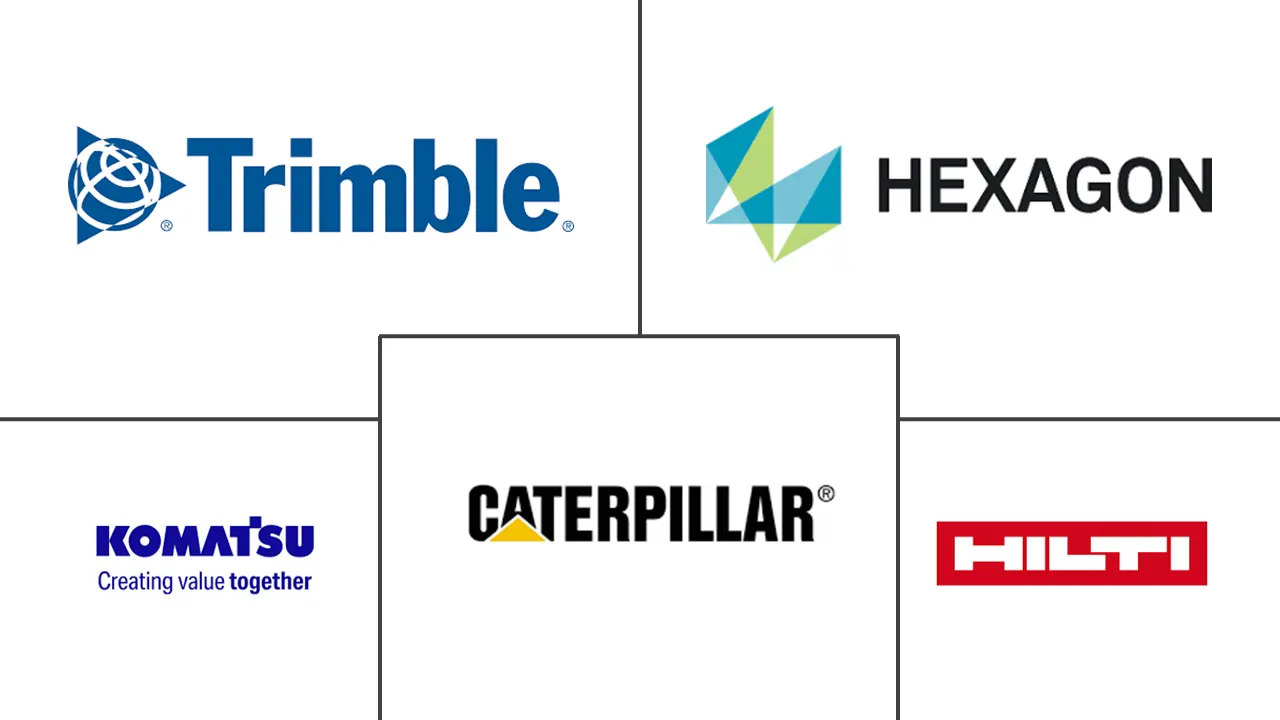IoT In Construction Market Size and Share
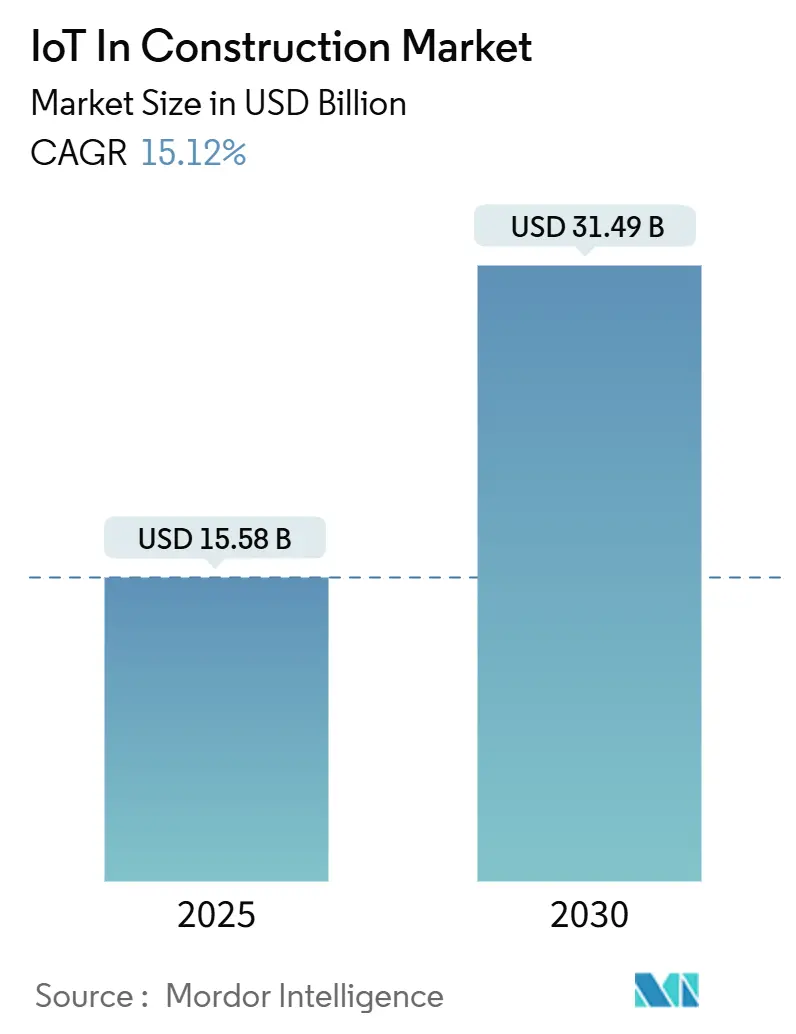
IoT In Construction Market Analysis by Mordor Intelligence
The IoT in construction market is valued at USD 15.58 billion in 2025 and is forecast to reach USD 31.49 billion by 2030, reflecting a 15.12% CAGR through the period. The expansion rests on three mutually reinforcing forces: the rollout of 5G connectivity, the maturing of edge‐computing architectures, and a steady decline in sensor prices. Together these elements allow contractors to analyze large data volumes in near real time, automate maintenance schedules, and comply with tightening carbon-tracking mandates. Falling hardware costs are particularly important for mid-tier builders because they lower the up-front investment required to retrofit older assets. Safety analytics platforms are another powerful catalyst, helping firms cut incident rates while collecting data that reduces insurance premiums by 10-15% on monitored sites. Competitive pressure also fuels adoption: equipment makers such as Caterpillar and technology specialists like Trimble are embedding connectivity into their core products, turning traditional machinery into data-rich platforms.
Key Report Takeaways
- By component, hardware captured 48% of IoT in construction market share in 2024; services are projected to grow at an 18.20% CAGR to 2030.
- By deployment mode, cloud solutions led with 38.50% revenue share in 2024, while the same segment is forecast to expand at a 19.80% CAGR through 2030.
- By end user, commercial and industrial applications held 62% of the IoT in construction market size in 2024; residential usage is accelerating at a 20.50% CAGR through 2030.
- By geography, North America accounted for 38.50% share of the IoT in construction market size in 2024, whereas Asia-Pacific is the fastest-growing region with a 19.80% CAGR to 2030.
Global IoT In Construction Market Trends and Insights
Drivers Impact Analysis
| Driver | (~) % Impact on CAGR Forecast | Geographic Relevance | Impact Timeline |
|---|---|---|---|
| Improved safety-at-site analytics | +2.8% | North America, EU | Medium term (2-4 years) |
| Real-time asset tracking and predictive maintenance | +3.2% | Global, strongest in Asia-Pacific | Short term (≤ 2 years) |
| 5G and edge computing roll-out on jobsites | +2.5% | North America, Asia-Pacific | Medium term (2-4 years) |
| Mandatory carbon-emission logging on projects | +1.9% | EU, North America, Asia-Pacific | Long term (≥ 4 years) |
| Falling cost of digital-twin sensors for mid-tier firms | +2.1% | Global | Short term (≤ 2 years) |
| Insurance premium discounts for IoT-monitored sites | +1.7% | North America, EU | Medium term (2-4 years) |
| Source: Mordor Intelligence | |||
Improved safety-at-site analytics
IoT wearables and environmental sensors continuously capture data on noise, dust, motion, and proximity. Platforms analyze these streams and alert supervisors within seconds, lowering incident rates while creating auditable safety records that insurance companies now recognize with premium reductions.[1]AXA XL, “Connected Jobsite Safety and Insurance Benefits,” axaxl.com Users report fewer lost-time injuries and faster root-cause analysis, reinforcing the business case for connected safety gear.
Real-time asset tracking and predictive maintenance
Linking IoT sensors to machine-learning models allows contractors to service equipment according to condition rather than calendar schedules. Trackunit’s global network of more than 1 million connected machines demonstrates how remote diagnostics can cut downtime by 20-25% and maintenance outlays by 18%.[2]Cisco, “Trackunit Expands Global Construction IoT,” cisco.com The same telemetry data supports emissions reporting, helping firms meet new regulatory requirements on fuel usage and idle time.
5G and edge computing roll-out on jobsites
Fifth-generation networks carry massive sensor loads with latency measured in single-digit milliseconds, unlocking autonomous equipment and immersive collaboration tools. China Construction’s Beijing “smart site” deploys 5G-enabled AI glasses and health-monitoring wearables to boost productivity 15-20% through low-latency data exchange.[3]KHL, “Beijing Smart Construction Site Uses 5G,” khl.com Edge gateways preprocess high-volume video and LiDAR data on-site, minimizing bandwidth bottlenecks.
Mandatory carbon-emission logging on projects
Public agencies increasingly require realtime disclosure of construction-site emissions. Turner Construction used connected sensors to save 9,583 gallons of diesel and avoid 97.85 metric tons of CO₂ on a California university project The data flow feeds ESG dashboards and blockchain ledgers that preserve audit trails for regulators and investors.
Restraints Impact Analysis
| Restraint | ( ) % Impact on CAGR Forecast | Geographic Relevance | Impact Timeline |
|---|---|---|---|
| High implementation and retrofit costs | -2.4% | Global, SMEs | Short term (≤ 2 years) |
| Data-security and privacy liabilities | -1.8% | Global, stringent in EU | Medium term (2-4 years) |
| Sensor-equipment interoperability gaps | -1.5% | Global | Medium term (2-4 years) |
| Job-site skills shortage in IoT data analytics | -2.1% | North America, EU | Long term (≥ 4 years) |
| Source: Mordor Intelligence | |||
High implementation and retrofit costs
Although sensor prices have fallen, full integration requires gateways, connectivity, and software configuration that often doubles budgets when legacy equipment must be adapted. Financing models such as Trimble’s tiered subscriptions spread costs over time, but capital outlays remain a hurdle for small contractors.
Data-security and privacy liabilities
A wider attack surface accompanies every new connected device. IoT-related breaches rose 25% across industrial sectors, and the mobile, temporary networks common on construction sites heighten exposure. Privacy issues also arise from wearables that track worker biometrics, driving additional compliance costs under regulations like GDPR.
Segment Analysis
By Type: Hardware Foundation Enables Software Innovation
Hardware captured 48% of IoT in construction market share in 2024, anchored by environmental sensors, wearables, asset tags, and edge computing hardware that form the essential data-gathering layer. The strong base reflects the sector’s need for ruggedized devices able to endure dust, vibration, and extreme temperatures. Software claimed roughly 32% and focuses on analytics, digital twins, and workflow orchestration, translating raw data into actionable insights for planners and site managers. Services, though representing 20%, are advancing quickest at an 18.20% CAGR as contractors outsource integration, management, and data science to specialized vendors. Trimble now earns 75% of revenue from software and services, underscoring the shift to subscription models that smooth cash flow and reduce up-front risk.
Hardware vendors increasingly bundle managed services, positioning themselves as one-stop partners rather than component suppliers. The result is tighter alignment of incentives: providers gain recurring revenue while clients receive performance guarantees tied to uptime or energy savings. AI modules embedded in service packages automate parameter tuning and generate predictive alerts, reinforcing the ROI narrative and expanding the overall IoT in construction market. This interplay of physical assets and cloud intelligence keeps the IoT in construction industry on a steep innovation curve.
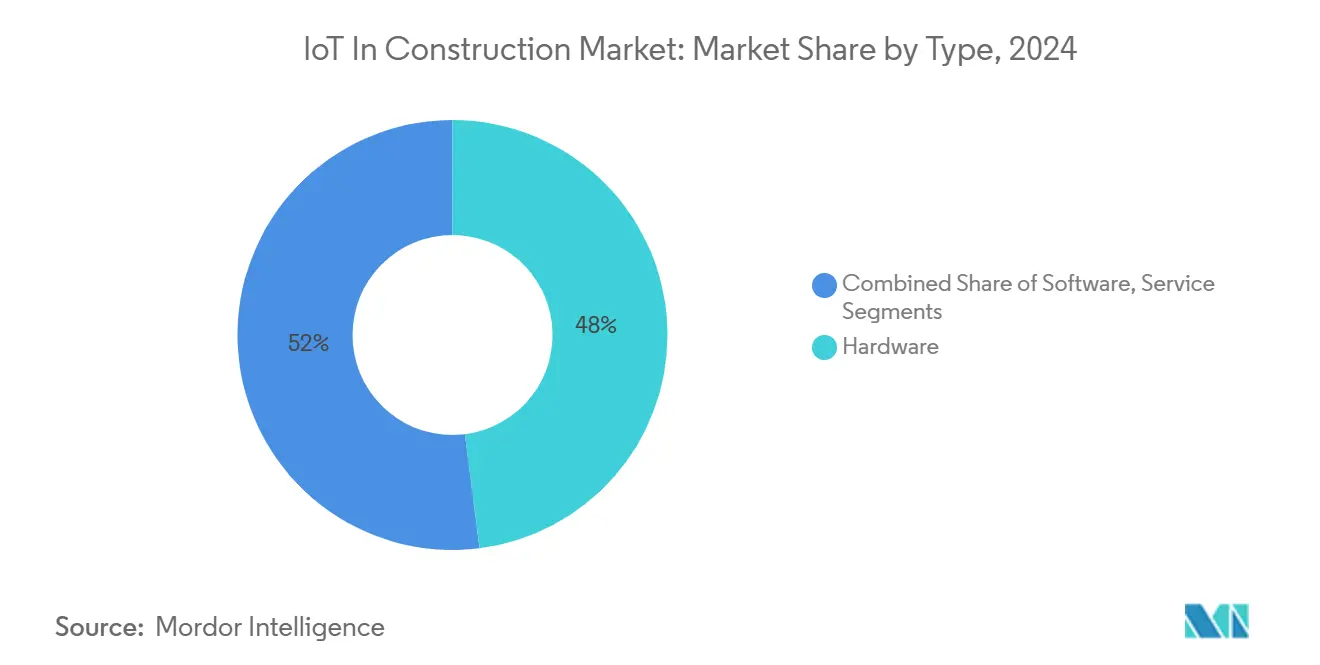
Note: Segment shares of all individual segments available upon report purchase
By Deployment Mode: Cloud Dominance Accelerates Digital Transformation
Cloud platforms held 38.50% share in 2024 and simultaneously posted the highest growth rate at 19.80% CAGR, illustrating a decisive swing toward scalable, location-agnostic systems. Remote management became mission-critical during the pandemic, prompting firms such as Swinerton to move document workflows and digital twins entirely online, thereby eliminating client travel and cutting review cycles. On-premise solutions still run 61.50% of workloads, favored by large enterprises with proprietary security policies or limited Internet connectivity on certain sites.
The market is now gravitating toward hybrid architectures: sensitive design files remain on local servers while analytics engines spin up in the cloud to crunch telematics data. Hexagon’s Reality Cloud Studio combines web-based visualization with optional edge processing for latency-sensitive tasks. Edge computing thus complements the cloud, enabling millisecond responses for autonomous machines without sacrificing the macro-level insights that only scalable analytics can provide. These flexible arrangements enlarge the IoT in construction market size by lowering the switching cost for firms still operating onsite data centers.
By End-user: Commercial Dominance Meets Residential Acceleration
Commercial and industrial projects controlled 62% of the IoT in construction market size in 2024 on the back of complex infrastructure builds, large capital budgets, and clear productivity metrics that justify technology spend. Corporate campuses, manufacturing plants, and transportation hubs already track heavy equipment fleets, monitor structural health, and optimize energy use. General contractors such as Skanska and Turner formalize innovation budgets and measure returns, giving their pilot programs scale and longevity.
Residential adoption, while smaller at 38%, is growing by 20.50% CAGR as smart-home expectations spill into new-build specifications. Developers integrate climate control, intrusion detection, and leak monitoring during construction, lowering retrofit costs for owners. The crossover between consumer IoT and jobsite technology blurs traditional categories and brings volume buying power that further reduces sensor prices. As mid-market builders bundle these features into multi-family housing, the IoT in construction market gains breadth and resilience. The trend also seeds a new service layer for post-handover maintenance contracts, reinforcing the long-term revenue profile for technology providers.
Geography Analysis
North America retained leadership with a 38.50% share of the IoT in construction market in 2024 thanks to early 5G rollouts, clear legal frameworks, and strong collaboration between equipment makers and software firms. Major cloud providers host data in regionally distributed centers, easing compliance with state regulations. Insurance carriers headquartered in the United States actively promote IoT-enabled risk mitigation, further accelerating uptake.
Asia-Pacific is advancing at a 19.80% CAGR through 2030, the fastest regional growth trajectory, propelled by large urbanization projects and supportive national strategies in China, India, and members of ASEAN. Infrastructure megaprojects adopt sensor packages to manage asset lifecycles, while government agencies standardize data formats that encourage vendor competition and price declines. Indigenous technology suppliers now account for a growing share of deployments, tailoring solutions to local languages and regulations.
Europe shows steady expansion as the bloc’s Green Deal mandates rigorous carbon accounting. Builders deploy connected meters and blockchain-verified logs to meet public tender requirements. Meanwhile, the Middle East and Africa remain nascent markets but display rising demand as multibillion-dollar transport corridors and smart-city programs specify IoT from project inception. Taken together, these dynamics ensure that the IoT in construction market maintains geographic diversification, reducing exposure to regional downturns.
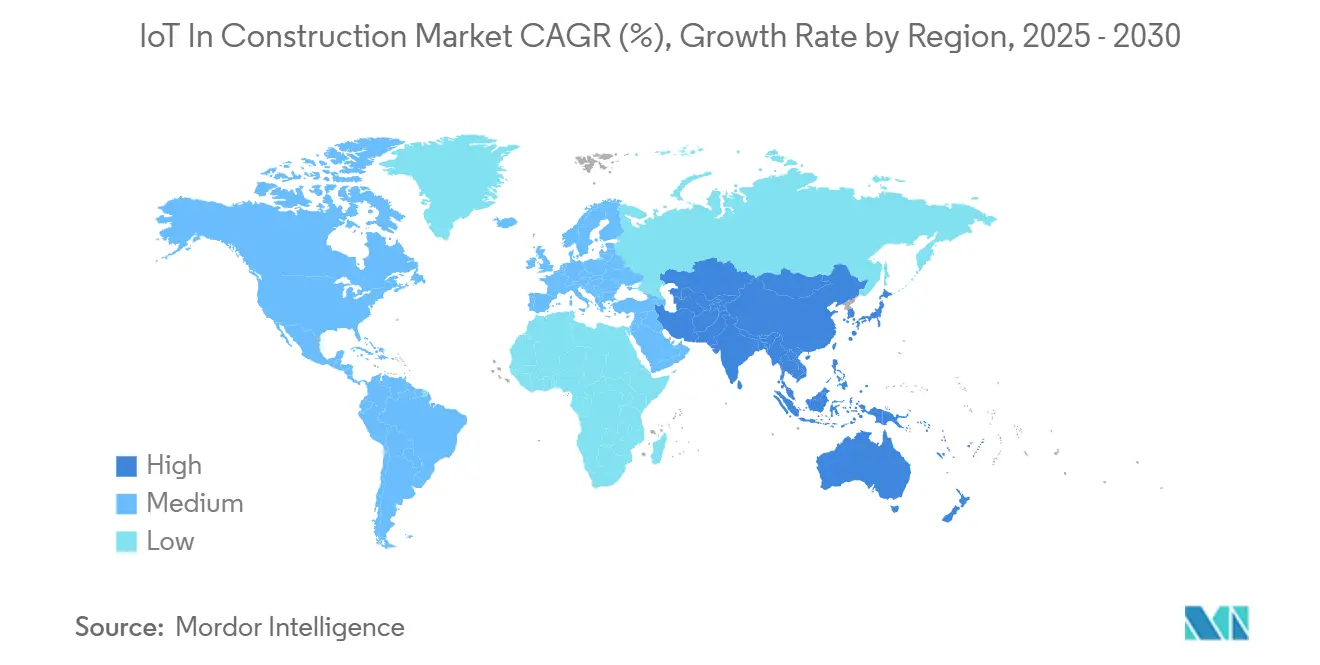
Competitive Landscape
Competition is intensifying as traditional equipment manufacturers converge with pure-play software vendors. Caterpillar, Komatsu, and Volvo embed telematics modules as standard equipment, transforming heavy machinery into rolling data nodes. Trimble pursues a “Connect & Scale” agenda that links field hardware to cloud analytics and posts USD 2.03 billion in annual recurring revenue, demonstrating market appetite for subscription models. Hexagon prepares a USD 1.578 billion spin-off of its Asset Lifecycle Intelligence unit, signaling confidence in specialized platforms focused on construction workflows.
Smaller innovators such as Converge and Brickeye address niche pain points—concrete curing and environmental monitoring respectively—then expand through partnerships with incumbents. Platform interoperability has become a prime battleground: builders demand seamless integration across scheduling, cost control, safety, and sustainability dashboards. Consequently, open APIs and neutral data hubs distinguish market leaders from locked-in ecosystems.
IoT In Construction Industry Leaders
-
Trimble Inc.
-
Caterpillar Inc.
-
Hexagon AB (Leica Geosystems)
-
Komatsu Ltd. (SmartConstruction)
-
Hilti Group
- *Disclaimer: Major Players sorted in no particular order
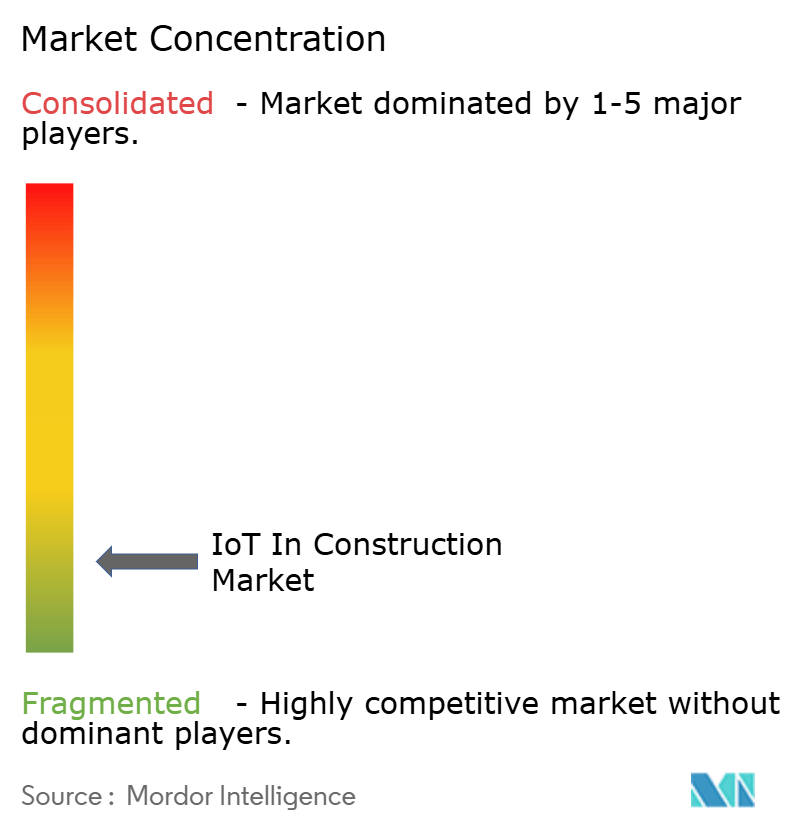
Recent Industry Developments
- March 2025: Trimble launches tiered subscription bundles for connected construction.
- September 2024: Leica Geosystems unveils GS05 GNSS smart antenna for surveying.
- August 2024: SAP and Hilti integrate cloud-based PLM solutions.
- February 2024: Netmore acquires Senet to expand LoRa network for construction IoT.
Global IoT In Construction Market Report Scope
IoT devices can help with digital transformation by allowing software construction companies to access real-time data. The information allows faster, more accurate insights and better management. Digital transformation also allows for the automation of time-consuming tasks.
The IoT in construction market is segmented by type (hardware, software, services), by end-user (commercial, residential), by geography (North America, Europe, Asia-Pacific, Latin America, Middle East and Africa). The market sizes and forecasts are provided in terms of value (USD) for all the above segments.
| Hardware |
| Software |
| Services |
| On-premise |
| Cloud |
| Commercial and Industrial |
| Residential |
| North America | United States | |
| Canada | ||
| Mexico | ||
| South America | Brazil | |
| Argentina | ||
| Rest of South America | ||
| Europe | United Kingdom | |
| Germany | ||
| France | ||
| Italy | ||
| Spain | ||
| Russia | ||
| Rest of Europe | ||
| Asia-Pacific | China | |
| Japan | ||
| India | ||
| South Korea | ||
| Australia and New Zealand | ||
| Rest of Asia-Pacific | ||
| Middle East and Africa | Middle East | Saudi Arabia |
| UAE | ||
| Turkey | ||
| Rest of Middle East | ||
| Africa | South Africa | |
| Nigeria | ||
| Kenya | ||
| Rest of Africa | ||
| By Type | Hardware | ||
| Software | |||
| Services | |||
| By Deployment Mode | On-premise | ||
| Cloud | |||
| By End-user | Commercial and Industrial | ||
| Residential | |||
| By Geography | North America | United States | |
| Canada | |||
| Mexico | |||
| South America | Brazil | ||
| Argentina | |||
| Rest of South America | |||
| Europe | United Kingdom | ||
| Germany | |||
| France | |||
| Italy | |||
| Spain | |||
| Russia | |||
| Rest of Europe | |||
| Asia-Pacific | China | ||
| Japan | |||
| India | |||
| South Korea | |||
| Australia and New Zealand | |||
| Rest of Asia-Pacific | |||
| Middle East and Africa | Middle East | Saudi Arabia | |
| UAE | |||
| Turkey | |||
| Rest of Middle East | |||
| Africa | South Africa | ||
| Nigeria | |||
| Kenya | |||
| Rest of Africa | |||
Key Questions Answered in the Report
What is the current value of the IoT in construction market?
The market stands at USD 15.58 billion in 2025, with a forecast value of USD 31.49 billion by 2030.
Which region leads IoT adoption in construction?
North America holds the largest share at 38.50%, supported by advanced 5G coverage and favorable regulations.
Which deployment mode is growing fastest?
Cloud solutions are expanding at a 19.80% CAGR as contractors prioritize remote accessibility and flexible scaling.
How are safety analytics influencing market growth?
Wearable and environmental sensors reduce incident rates and lower insurance premiums, contributing a 2.8% positive impact on the forecast CAGR.
Page last updated on:
